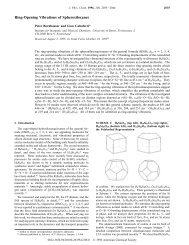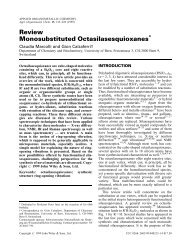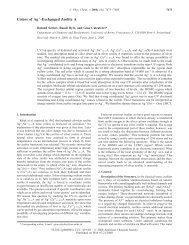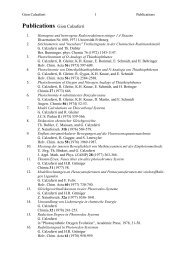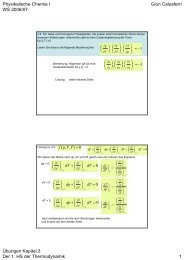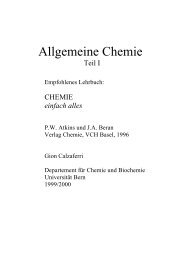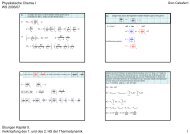Photonic antenna system for light harvesting
Photonic antenna system for light harvesting
Photonic antenna system for light harvesting
You also want an ePaper? Increase the reach of your titles
YUMPU automatically turns print PDFs into web optimized ePapers that Google loves.
adhesion 34 and electric fields. 35 The morphology and the size of<br />
the crystals are important in all cases. ZSM-5 nanoscale seed<br />
crystals have been organised with their largest area surface on<br />
positively charged polymers on a gold surface. Calcination and<br />
growth of the silicalite then led to a densely packed and<br />
oriented polycrystalline layer. 36 Zeolite L crystals can be<br />
organised by modifying them with charged stopcock molecules.<br />
This leads to an anisotropic distribution of the zeolite surface<br />
charges and gives rise to attractive electrostatic interactions<br />
with an oppositely charged substrate. The crystal growth of<br />
AlPO-5 in the presence of floating anodised alumina can be<br />
controlled to obtain vertically aligned hexagonal crystals. 37<br />
To further suppress the insertion of dyes into the channels<br />
from the substrate-side, the channels can be sealed on one<br />
side by adsorption of a polymer onto the substrate. 38<br />
Alternatively, stopcocks can be functionalised specifically<br />
with electro-reactive constituents like ethynylic-, 39 vinylic- 40<br />
or pyrrolic-groups. 41,42 The substrate serves as electrode under<br />
the influence of an electrochemical potential and only the<br />
adjacent heads of the stopcocks react to <strong>for</strong>m a covalently cross<br />
linked structure. The stopcocks are then removed from the<br />
other side of the crystals to unblock the channels <strong>for</strong> the dye<br />
insertion.<br />
The <strong>for</strong>mation of mono-directional <strong>antenna</strong> materials by<br />
organising different dye loaded crystals is illustrated in Fig. 15b)<br />
and c). Assembly of layered organic–inorganic composites is<br />
currently a major research area. 43,44 An increasing number of<br />
articles concerning the assembly of zeolite crystals on<br />
substrates via ionic or covalent bonding, some by the use of<br />
appropriate organic additives, have been published. 45–49 This<br />
knowledge can be used <strong>for</strong> alternate adsorption of charged<br />
polymers and zeolite L crystals modified with stopcocks<br />
bearing a charged head as illustrated in Fig. 15b). Polymeric<br />
materials ranging from biopolymers such as proteins 50,51 to<br />
inorganic macromolecules and clays 52,53 have been assembled<br />
by means of related techniques. Luminescent polymers can be<br />
used as connectors to transport the energy from one crystal to<br />
another one. 54 A simpler concept consists of arranging<br />
differently charged crystals in the manner shown in Fig. 15c).<br />
5. Applications<br />
The tunability in size and properties of the materials described<br />
in the previous sections is so large that we expect them to find<br />
applications in different fields such as optoelectronics,<br />
pigments, molecular probes but also as educational tools. We<br />
focus on five applications amongst these. Some of them are<br />
already feasible, while others require further development.<br />
5.1 Educational tools<br />
There are not many demonstration experiments which show<br />
the process of energy transfer and energy migration well. We<br />
found that the energy transfer between dye molecules inside the<br />
channels of zeolite L works so well that it can be used as a nice<br />
educational tool to show both energy transfer and energy<br />
migration. The reason <strong>for</strong> this is that the dye molecules can be<br />
brought close together without <strong>for</strong>ming dimers. We can vary<br />
the mean distance between the molecules by varying the<br />
occupational probability of the dyes which is directly proportional<br />
to the concentration of the dyes in the zeolite channels.<br />
The volume of a zeolite crystal is given by:<br />
VZ~pr 2 cyl lcyl<br />
where r cyl is the radius of the zeolite crystal and l cyl is the length<br />
of the zeolite crystal. The number of unit cells of one crystal, nuc<br />
is given by:<br />
(3)<br />
nuc~ 2p ffiffi<br />
3<br />
p lcylr 2 cyl<br />
2<br />
jja c<br />
jj 2<br />
where c and a are the primitive vectors of the zeolite L<br />
framework. Now the number of channels in a zeolite crystal<br />
can be written as:<br />
nch~ nucjj c<br />
(5)<br />
lcyl<br />
If ns is the number of unit cells that <strong>for</strong>ms a site and pdye is the<br />
occupational probability of dyes, then the number of dyes in<br />
the zeolite crystal is:<br />
ndye~ lcylnch<br />
nsjj c<br />
pdye<br />
(6)<br />
Now we can calculate a mean volume element that a dye<br />
occupies in the zeolite crystal and if we consider this volume<br />
element as a cube we can calculate the length of the cube. If we<br />
use a 1 : 1 mixture of donor D and acceptor A, this length is<br />
approximately the mean distance between D and A:<br />
RDA^( VZ<br />
ndye<br />
) 1 3~( 1<br />
2<br />
pdye<br />
(4)<br />
pffiffiffi 2 ns<br />
3jja<br />
c j j ) 1 3 (7)<br />
This equation shows that the mean distance between two<br />
molecules is only dependent on some geometrical factors and of<br />
the occupational probability of the dyes. The occupational<br />
probability can be regarded as a tool to vary the mean distance<br />
between dye molecules.<br />
We concentrated on the two cationic dyes Py z and Ox z<br />
which can be incorporated into zeolite L from aqueous solution<br />
with about equal rates. Both dyes have a large fluorescence<br />
quantum efficiency and there<strong>for</strong>e radiationless relaxation is not<br />
considered. If a 1 : 1 mixture of the two dyes is used we can look<br />
at the mechanism of energy transfer from Py z (donor D) to<br />
Ox z (acceptor A). We can also modify Py z -loaded zeolite L<br />
crystals with one molecule of Ox z on average at all channel<br />
endings. By varying the occupational probability of Py z ,<br />
energy migration to the crystal endings can be tuned from poor<br />
to efficient.<br />
The energy transfer in these materials can easily be observed<br />
when a series of samples is put in a black box as shown in<br />
Fig. 16. The samples were excited using a Mini Mag-Lite 1 AA<br />
flash<strong>light</strong> and a Schott DAD 8-1 interference filter at<br />
486.7¡5 nm. The <strong>light</strong> beam has to be perpendicular to the<br />
interference filter and to the sample. The emission <strong>light</strong> is<br />
observed through a Schott OG 515 cut-off filter. The sample<br />
and the cut-off filter are not perpendicular to the observation<br />
angle so as to minimise reflection effects.<br />
The transmission spectra of the two filters and the<br />
Fig. 16 Black box <strong>for</strong> observation of energy transfer and energy<br />
migration demonstration experiments. 1: Mag-Lite 1 AA flash<strong>light</strong>, 2:<br />
Schott DAD 8-1 interference filter at 486.7¡5 nm, 3: sample, 4: Schott<br />
OG 515 cut-off filter.<br />
J. Mater. Chem., 2002, 12, 1–13 9





